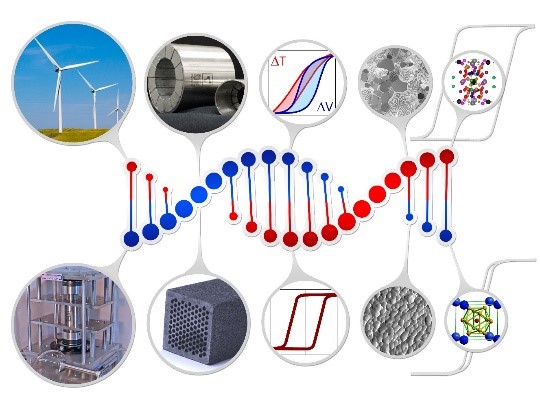Hysteresis design of magnetic materials for efficient energy conversion
Oliver Gutfleisch, Technical University Darmstadt, Germany
 © Functional Materials
© Functional MaterialsMagnets are key components of energy-related technologies, such as direct drive wind turbines and e-mobility. They are also important in robotics and automatisation, sensors, actuators, and information technology. The magnetocaloric effect (MCE) is of strong interest for new and disruptive solid state-based refrigeration. Both material families, permanent magnets and magnetocalorics, require strategic metals, which need to be assessed in terms of their criticality. Magnetic hysteresis – and its inherent energy product – characterises the performance of all magnetic materials. Despite considerable progress in the modelling, characterisation and synthesis of magnetic materials, hysteresis is a long-studied phenomenon that is still far from being completely understood. Discrepancies between intrinsic and extrinsic magnetic properties remain an open challenge and magnets do not operate yet at their physical limits. The design of hysteresis for the magnets for the above applications requires an expanded detailed knowledge on different length scales. Ultimately, new strategies for effective magnetic hardening mechanisms of permanent magnets resisting high external magnetic fields and temperatures and for strong thermomagnetic responses in low fields of magnetocaloric materials are needed.
In this context, I will introduce our newly established DFG Cooperate Research Center 270 Hommage Hysteresis Design of Magnetic Materials for Efficient Energy Conversion between TU Darmstadt and University of Duisburg-Essen.
[1] O. Gutfleisch, M. A. Willard, E. Brück, C. H. Chen, S. G. Sankar, and J. P. Liu, Magnetic materials and devices for the 21st century: stronger, lighter, and more energy efficient. Adv. Mater. 23 (2011) 82.
[2] K.P. Skokov and O. Gutfleisch, Heavy rare earth free, free rare earth and rare earth free magnets – vision and reality, Scripta Materialia View Point Set, 154 (2018) 289-294.
[3] T. Gottschall, A. Gracia-Condal, M. Fries, A. Taubel, L. Pfeuffer, L. Manosa, A. Planes, K.P. Skokov, O. Gutfleisch, A multicaloric cooling cycle that exploits thermal hysteresis, Nature Materials (2018).
[4] M. Duerrschnabel, M. Yi, K. Uestuener, M. Liesegang, M. Katter, H.-J. Kleebe, B. Xu, O. Gutfleisch, L. Molina-Luna, Atomic structure and domain wall pinning in samarium -cobalt based permanent magnets, Nature Communications 8:54 (2017).
[5] J. Liu, T. Gottschall, K.P. Skokov, J.D. Moore, O. Gutfleisch, Giant magnetocaloric effect driven by structural transition, Nature Mat. 11 (2012) 620.
[6] O. Gutfleisch, T. Gottschall, M. Fries, D. Benke, I. Radulov, K. P. Skokov, H. Wende, M. Gruner, M. Acet, P. Entel and M. Farle, Mastering hysteresis in magnetocaloric materials, Phil. Trans. R. Soc. A 374 (2016) 20150308.
[7] R. Gauss und O. Gutfleisch, Magnetische Materialien – Schlüsselkomponenten für neue Energietechnologien, in Rohstoffwirtschaft und gesellschaftliche Entwicklung, ed. P. Kausch und J. Matschullat, März 2016, Springer Spektrum Heidelberg, Springer-Verlag GmbH, ISBN 978-3-662-48854-6, pp. 99-118.

